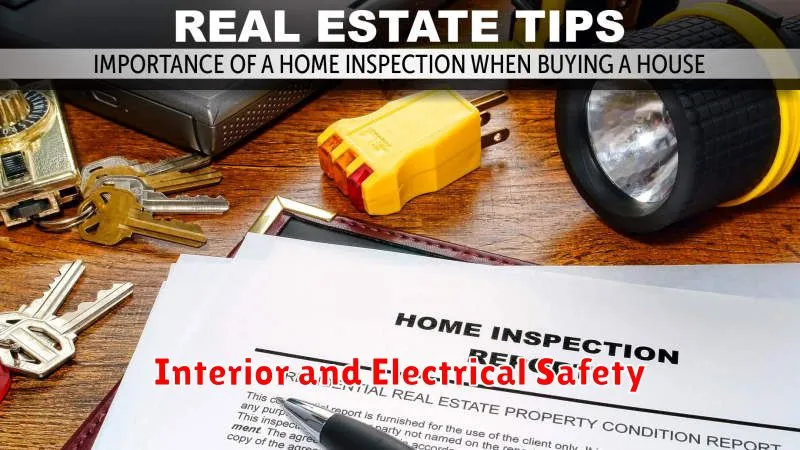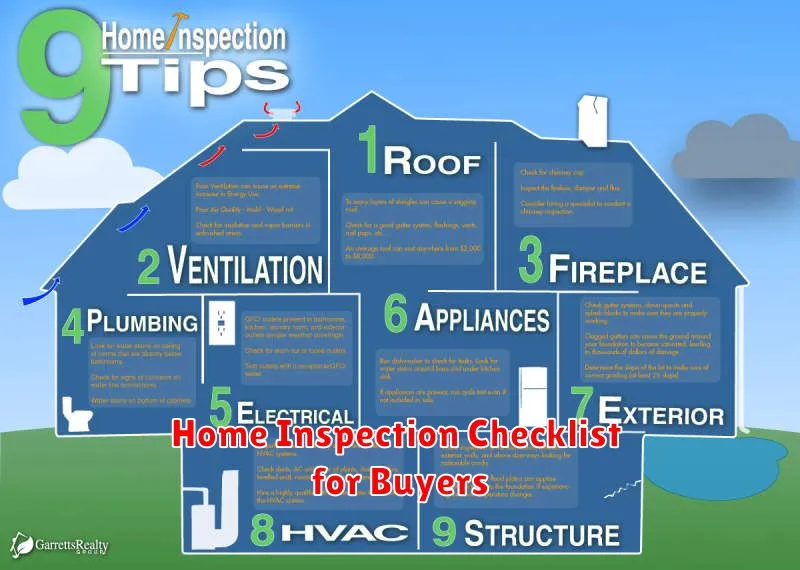Purchasing a home is a significant investment, and a comprehensive home inspection is crucial for protecting that investment. A thorough home inspection checklist provides prospective buyers with an objective assessment of a property’s condition, empowering them to make informed decisions. This checklist helps identify potential issues that may not be readily apparent, such as structural problems, plumbing or electrical deficiencies, roofing concerns, and more. By understanding the importance of a home inspection checklist and utilizing a detailed one, buyers can avoid costly surprises and negotiate repairs or adjustments to the purchase price before finalizing the deal.
This home inspection checklist for buyers covers key areas of a property, including the exterior, interior, roof, attic, basement, plumbing, electrical systems, heating, ventilation, and air conditioning (HVAC). Using this guide, buyers can actively participate in the inspection process and gain a comprehensive understanding of the home’s true condition. A well-executed home inspection, aided by a comprehensive home inspection checklist, provides invaluable peace of mind and safeguards buyers from unforeseen expenses. Reviewing this checklist prior to the inspection will ensure you are well-prepared to address all important aspects of the property.
Why a Home Inspection Is Essential
A home inspection is a crucial step in the home-buying process. It provides an objective evaluation of the property’s condition, identifying potential problems that may not be readily apparent. This allows prospective buyers to make informed decisions about whether to proceed with the purchase, negotiate repairs, or reconsider the offer entirely. The inspection report details the condition of various systems, including structural components, electrical wiring, plumbing, heating, and cooling. By understanding the true state of the property, buyers can avoid costly surprises and unexpected repairs down the road.
Beyond simply uncovering existing issues, a home inspection also serves as a valuable tool for future planning. The inspector’s findings can highlight areas that may require maintenance or upgrades in the near future, allowing buyers to budget accordingly. For example, an aging roof or outdated HVAC system might not pose an immediate threat, but understanding their lifespan can help homeowners anticipate and prepare for future expenses. This proactive approach can save significant money and prevent major inconveniences in the long run.
Finally, a home inspection offers peace of mind for both buyers and sellers. For buyers, it provides the confidence that they are making a sound investment in a property that is structurally sound and safe. For sellers, it allows them to address any potential concerns proactively, facilitating a smoother transaction and potentially preventing future legal disputes. In this sense, the relatively small cost of a home inspection is a worthwhile investment that protects both parties involved in the real estate transaction.
What Inspectors Typically Look For
Home inspectors assess the condition of a property’s major systems and components. They typically focus on the structural integrity of the foundation, roof, and exterior walls, looking for signs of damage, deterioration, or potential safety hazards. Inspectors also carefully examine the electrical system, including wiring, panels, and outlets, as well as the plumbing system, checking for leaks, water pressure issues, and proper drainage. Heating and cooling systems are also a key area of focus, with inspectors evaluating their efficiency and functionality. In addition, inspectors will look at the overall condition of the interior, including walls, floors, and ceilings, noting any defects or areas of concern.
Beyond these major systems, inspectors also pay attention to various other aspects of the property. These include the condition of appliances such as ovens, dishwashers, and refrigerators, as well as the presence of any safety devices like smoke detectors and carbon monoxide detectors. Exterior elements like grading, drainage, and landscaping are also assessed to ensure they do not pose any threats to the property’s foundation or structure. Finally, the inspector will examine the attic and crawl space (if accessible) to check for insulation, ventilation, and potential pest infestations.
The goal of a home inspection is to provide a comprehensive overview of the property’s condition, highlighting any potential problems that may require attention. While inspectors do not offer repair services, their findings can empower buyers to make informed decisions about their purchase, negotiate repairs with the seller, or reconsider the transaction altogether. It’s important to remember that home inspections are primarily visual assessments, and they may not uncover every hidden issue. However, they serve as a valuable tool in helping buyers understand the overall condition of their prospective home.
Exterior and Roofing Checklist

Regular exterior and roofing inspections are crucial for maintaining your property’s value and structural integrity. A thorough assessment helps identify potential problems early, preventing costly repairs down the road. This checklist covers key areas to inspect for both the exterior walls and the roof.
For the exterior walls, check for signs of damage such as cracks, peeling paint, or loose siding. Inspect the foundation for settling, cracks, or evidence of water intrusion. Examine all windows and doors for proper sealing and functionality. Ensure gutters and downspouts are clear of debris and directing water away from the foundation.
Roof inspections should focus on the condition of shingles, looking for curling, missing, or damaged shingles. Check flashing around chimneys, vents, and skylights for proper sealing. Examine the gutters for signs of granule buildup, which can indicate shingle wear. Finally, look for any signs of sagging or unevenness in the roofline.
Interior and Electrical Safety

Interior safety focuses on preventing hazards within the home. This includes ensuring proper ventilation to prevent the buildup of harmful gases, securely anchoring furniture to prevent tip-overs, especially for young children, and using fire-resistant materials when possible. Regularly checking smoke and carbon monoxide detectors and having a practiced escape plan are also crucial aspects of maintaining a safe interior environment.
Electrical safety is paramount to preventing fires and electrocution. Avoid overloading outlets and use surge protectors for sensitive electronics. Inspect electrical cords for damage and replace them if frayed or cracked. Keep electrical appliances away from water sources, and ensure proper grounding for all electrical systems. Never touch electrical appliances or outlets with wet hands.
Integrating these safety measures into your home environment significantly reduces the risk of accidents and promotes overall well-being. Regularly inspecting and maintaining your home’s safety features, combined with practicing safe habits, can contribute to a secure and healthy living space.
Plumbing, Heating, and Cooling Systems

Plumbing systems manage the distribution of water and removal of waste within a building. Key components include pipes, fixtures (sinks, toilets, showers), and appliances like water heaters. Proper plumbing ensures safe delivery of clean water for consumption and sanitation, as well as efficient wastewater disposal to prevent health hazards and property damage. Regular maintenance, such as checking for leaks and clearing clogs, is crucial for optimal performance and longevity.
Heating systems provide warmth during colder months. Common types include furnaces (gas or oil), boilers, and heat pumps. These systems generate heat and distribute it throughout the building via ductwork, radiators, or radiant flooring. Regular inspections and maintenance, such as filter replacements and system cleaning, are essential for safety and efficiency. Proper insulation and ventilation are also important for maintaining comfortable temperatures and minimizing energy consumption.
Cooling systems, primarily air conditioning units, regulate indoor temperature during hot weather. These systems cool and dehumidify the air, improving comfort and air quality. Like heating systems, regular maintenance, such as cleaning coils and checking refrigerant levels, is vital for optimal performance and energy efficiency. Proper sizing and placement of cooling units are also critical for effectively cooling the space.
What to Do With the Inspection Report
After receiving your inspection report, carefully review it. Pay close attention to any items marked as safety concerns or major defects. These issues should be addressed promptly. Less urgent repairs can be prioritized based on your budget and timeline. Understanding the report’s findings is crucial for making informed decisions about your next steps, whether that’s negotiating repairs with a seller or planning for maintenance in your current home. If anything is unclear, don’t hesitate to contact your inspector for clarification.
If you’re buying a home, the inspection report provides valuable information for negotiating with the seller. You can request the seller to address certain repairs before closing, or ask for a credit to cover the costs yourself. Be prepared to discuss which items are most important to you. This is where prioritizing the major defects from the report comes into play. Remember, the seller may not agree to all your requests, and a compromise might be necessary. Having a clear understanding of your priorities will help guide this negotiation process.
Whether you’re buying or simply maintaining your current home, use the inspection report as a valuable tool for future upkeep. It helps identify potential problems early on, preventing them from becoming costly repairs down the road. Keep the report for your records and refer to it periodically to schedule necessary maintenance and address any issues before they escalate. The report provides a useful roadmap for maintaining your home’s value and ensuring a safe and comfortable living environment.
Questions to Ask Your Inspector
Before hiring a home inspector, it’s crucial to ask the right questions to ensure they are qualified and experienced. Inquire about their certifications and licenses, verifying they meet your state’s requirements. Ask about their experience inspecting homes similar to the one you’re purchasing, such as age, size, and construction type. Finally, inquire about their inspection process, including what they inspect, how long it takes, and what type of report they provide.
During the inspection, don’t hesitate to ask questions as they arise. If you observe something concerning, ask the inspector for clarification. Inquire about the severity of any issues found and potential solutions. Understanding the implications of their findings is essential for making informed decisions. It’s also helpful to ask about maintenance recommendations for the property, even for items not flagged as problems. This proactive approach can save you money and headaches down the line.
After receiving the inspection report, review it carefully. If anything is unclear, contact the inspector for further explanation. Don’t be afraid to ask follow-up questions to ensure you fully understand the report’s findings and their potential impact on your purchase decision. A clear understanding of the inspection results empowers you to negotiate repairs or reconsider the purchase if necessary.

